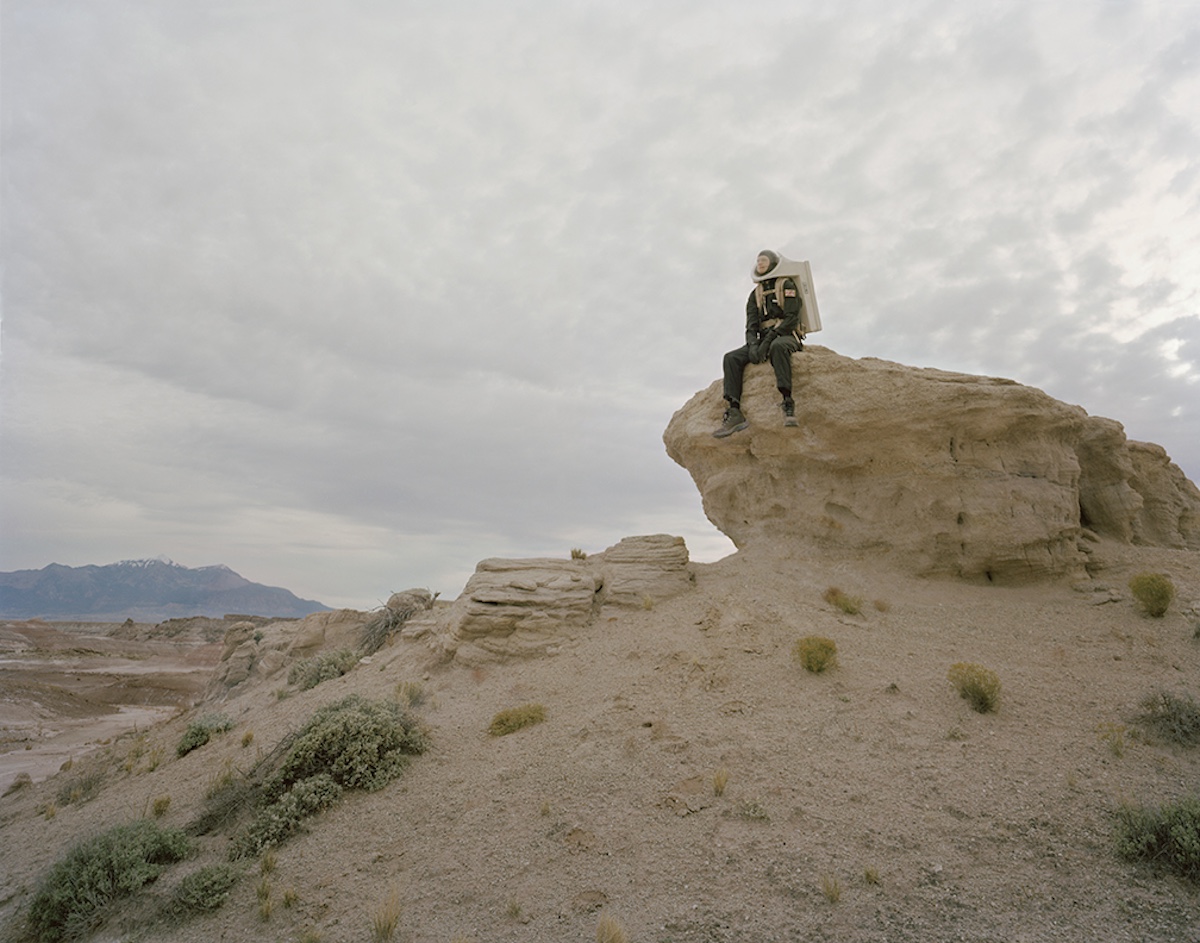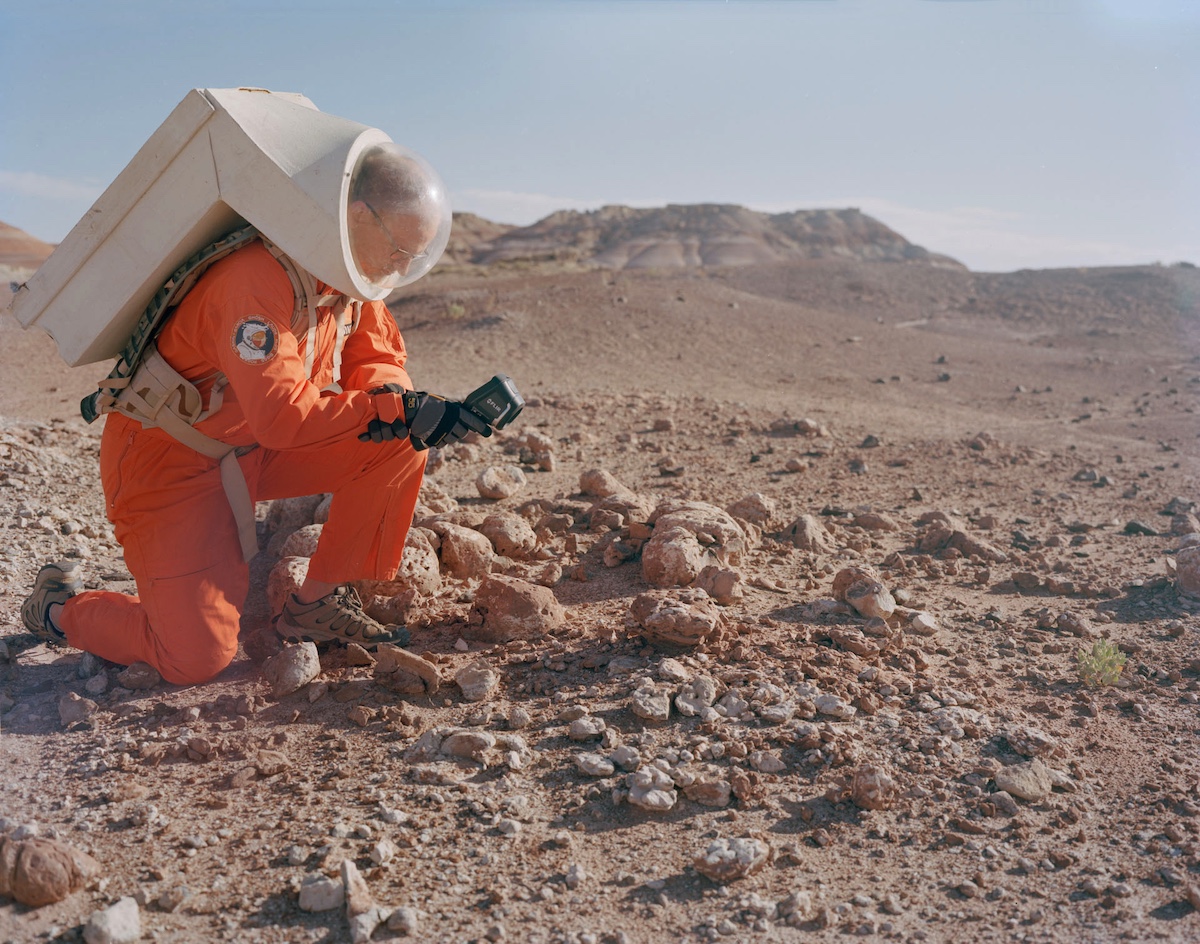At the Mars Desert Research Station near Hanksville, Utah, scientists conduct experiments as if they are on the Red Planet, the only caveat being that they aren’t.

Life on Mars looked awfully sleek from the road, like a movie set. A cluster of future-white domes stood in pristine contrast to the red rock desert.
But as I got closer to the station, the cracks in the facade began to show, literally. Insulation was blistering up from the paint. The door was slightly ajar on its hinges, not the airtight fit one might expect of these extraterrestrial accommodations. I only mention these details because ostensibly, this facility is one of the most believable renditions of a Mars dwelling outside of Hollywood. The Mars Desert Research Station near Hanksville, Utah, claims to be the largest and most robust Mars simulation facility on Earth. Since opening in 2001, hundreds of scientists have come here from around the world to inhabit a Martian state of mind while conducting research. A peeling sticker next to the door touted support from the Musk Foundation. In other words, this was supposed to be the place for Red Planet role play.
I pulled on the PVC handle in front of me, and the station door opened, not with a sci-fi swoosh, but with the squawk of styrofoam scraping against styrofoam. Finer details be damned, though. I would suspend my disbelief along with everything else—there’s 62% less gravity on Mars.
Act I — Crew 227
A voice over the intercom welcomed me and thus began the simulation. I entered the decompression chamber, where I stood for two long minutes while I “acclimated,” though the pressurized environment I was about to enter in this case had nothing to do with air quality and everything to do with the psychology of eight college students who had been cohabitating in a 500-square-foot dome for the past ten days while playing life on Mars.
The station offers researchers an opportunity to conduct experiments as if they really were on Mars, the only caveat being that they aren’t. I was curious how researchers would navigate this glaring plot hole, and the answer I found is the reason why this story now appears in a magazine of the arts, not sciences. This was not a cutting-edge research facility. This was something far more interesting to me. This was theater.
When I exited the decompression chamber, I was greeted by the crew astronomer who certainly looked the part of “eccentric astronaut” with his head wrapped in mesh netting and wires stuck to his face and down his arms.
Before I could inquire about his costume, he was ushering me through the props room, past a row of neatly hung space suits and their corresponding helmets, and a table stacked with maps and walkie-talkies. “These are actually just air conditioning,” he said, slapping the back of what was meant to look like an oxygen tank.
The building we were in, The Habitat, is one of five structures on the property. This is where crew members cook, use the bathroom, sleep, and store equipment for “extravehicular activities,” UTV outings in the desert, in this case. Peripheral to The Habitat, there is also a research lab, a greenhouse, and two telescope observatories.

“You have to try space food,” the astronomer said as we climbed the ladder to the living quarters where the rest of the crew was preparing lunch, which meant rehydrating a freeze-dried mash that suggested curry.
The crew was excited to have a visitor. It was nearing the end of their fourteen-day mission, and I was the first new person they’d seen since embarking. “Don’t tell me anything about Ukraine,” the crew commander said to me. He was referring to the war, which had only begun a few months prior at that point. The reference is obviously dated now—as I mentioned earlier, I never published this story, and my notes sat untouched for over two years. But the point of what the commander said still stands—he hadn’t read the news in over a week, and it felt great. And, the way he saw it, that feeling was relevant to one of the more philosophical goals of space exploration generally.
The biggest challenge of getting to Mars isn’t the technology. It’s the humans.
“When all you hear about is climate change and COVID and the war, it’s depressing. It makes people hate each other,” the commander said. “The dream of going to Mars brings people together.”
At lunch, I sat next to the crew engineer, who filled me in on the astronomer’s accoutrements. The engineer was studying the effects of hypnosis on sleep quality by observing electrical currents in each crew member’s brain before and after a session of hypnosis.
“I could do this research anywhere,” he admitted. Perhaps now is a good time to mention that the crew was from Belgium. “It’s not specific to Mars, but if people ever do go to Mars, they may have trouble sleeping, and this could be useful.”
After lunch, the greenhouse officer wanted to show me her seedlings, so we walked over to the research lab. “We had an infestation of white flies in the greenhouse, so I had to move everything over here,” she said. What would she do if that actually did happen on Mars? “That’s a good question,” she said. It was beyond the scope of her fourteen-day experiment.
Instead, she was investigating something even more complex—could seeds germinate in lower-gravity environments like Mars? “Some cells need stress to grow,” she explained. “They actually need the weight of gravity.” A compelling idea, but how was she testing this? We were in a plaster dome constructed in the style of a 1960s sci-fi movie, and as far as I could tell, the extent of her climate control was a swamp cooler and a grow light.

She was young, twenty-two. So I didn’t grill her on this point. Anyway, she had planted the seeds in Mars soil, and did I want to know about that instead? Of course. “You can buy this stuff on the internet,” she said, and then wrote down the name of her supplier—Exolith Labs. Rovers have reported back about the geological makeup of Mars, and it turns out we already have all the ingredients here on Earth.
In any case, I still wasn’t getting the answers I needed. Why did the crew need to come to Utah, to Mars, to do research they could have done in Belgium?
“It’s important to be here to know what to do when things go wrong,” the greenhouse officer said. “We can’t get new materials. That’s part of the simulation. We have to be creative.”
The safety officer had joined us in the research lab. She agreed with this point. “I don’t know what I don’t know,” she said. “Hopefully being in this environment can help me design experiments in the future.” Plus, she added, pretending she was on Mars could help come up with solutions for people on Earth. She was studying a special type of splint that could reset broken bones without surgery and with very little medical knowledge or skills, useful for people who live in remote areas without access to hospitals.
Eventually, we all reconvened in the kitchen. I wanted to know: would they go to Mars if they had the chance? I was surprised that none of them said yes. “It’s a one-way ticket,” said the engineer. Then why go through all the effort of researching the feasibility of supporting life on Mars?
I had exhausted the actors with my philosophical inquiries. This was a question for their director, Mission Control. So I bid them farewell.
Act II — Mission Control
I left The Habitat and exited stage right. Tucked behind a hill, out of sight from the station so as not to break the illusion of isolation, I found Mission Control in a camper van.
Shannon Rupert, then-director of the Mars Desert Research Station, hadn’t answered any of my calls or emails prior to my visit, and I wasn’t sure if she would talk to me. Luckily, as I approached her trailer, her dog bit my hand so hard it broke the skin. When I knocked on her door, she almost turned me away,something about hating the press coverage because it inspires trespassers, never mind that I had already talked to the public relations guy. But then I showed her my bleeding hand, and she let me in.
I loitered at her sink after washing the dog bite. I asked what brought her out here. “That’s a long story,” she said. I took a seat. She’d been living at the station on-and-off since 2016, training the crews, role-playing as Mission Control over a walkie-talkie, sneaking into The Habitat under the shroud of night to take out their trash (the simulation took some liberties with Earthly conveniences).
“I hate to credit a movie, but it all started with The Martian,” she said. In the 2015 box office hit, an astronaut is marooned on Mars and forced to survive on the Red Planet alone while his crew devises a plan to bring him back to Earth. The film portrays a conceivable and maybe not-so-distant future—the spacesuits, spacecrafts, and rovers are based on technologies we either already have or are close to creating. “The Martian caused a paradigm shift,” she said. “Before that, we were Comic-Con people. Now, space is cool. Mars research is legitimate.”

I considered the legitimacy of the Mars research I had just witnessed. Could she elaborate on the value of the research conducted here, given the limitations?
“We’ve gotten a lot of flack for not doing our own research,” she said. The station doesn’t dictate what researchers study and therefore—I’m reading between the lines here—takes no responsibility for the quality of the experiments. “We don’t do our own research because that’s not our goal. Our goal is to get as many people here who want to participate in the space community, and open their eyes to the possibilities.”
And as far as she’s concerned, any of the station’s technological shortcomings are beside the point anyway. “The biggest challenge of getting to Mars isn’t the technology,” she said. “It’s the humans.” Even if we could keep our fragile meat suits alive under the extreme conditions of Mars, could our psychology withstand such an existence? In this regard, perhaps human nature is the real topic of inquiry at the Mars Desert Research Station, with Rupert the lead author.
“I have a front-row seat to humanity,” she said. “Even just this season, we had a crew that only made it three days. There was this mass hysteria event over what they thought was a gas leak.” She’s seen “physical altercations” over hot cocoa, watched one researcher “just walk out of the simulation, didn’t say a word.” And every time a new crew arrives, “I know immediately who’s going to be the weakest link,” she said.
“Some of the crews come here and think that what happens on Mars stays on Mars,” she said. “That couldn’t be further from the truth. Being an astronaut means being surveilled 24/7. Would you be able to live under those conditions?” The crews aren’t surveilled per se at the station, but they are instructed to live as though Mission Control is watching, she said.
And what about her psychology? One could argue that her tenure in the ruthless desert of southern Utah, on make-believe Mars, in near-isolation, living one 500-gallon tank of water at a time, was the station’s most intriguing study. What had life in this red desert taught her about being human?
For starters, that shopping was an essential aspect of the human condition. “I’ve never been a big shopper, but every time I leave here, all I want to do is shop,” she said. “I think it’s because I crave the human interaction.” In lieu of shopping while at the station, she collects rocks. “I call it retail therapy,” she said. “I just want to look at stuff.”
On a more personal level, she found that living here had emboldened her. “I’ve realized I can do almost anything now,” she said. “There’s a lot of satisfaction in that.” She came here in pursuit of science, sure. But she was looking for independence, too. “I’ve had two failed marriages,” she said. “I’ve always been a wanderer.”
But while her sense of empowerment has grown stronger with time, her enthusiasm for scientific pursuits has waned in recent years.
“What attracted me to this work originally was that it mixed science with vision,” she said. “But the vision has changed. Going to Mars used to be about exploring. It used to be this noble thing, science for science’s sake. Now, a lot of the research is about extraction. You hear a lot of these big space guys talk about going to the moon or Mars, and it’s not about the betterment of humankind. It’s about what they can exploit.”
This brought to mind the image of Rupert surreptitiously removing bags of trash from The Habitat. On a grander scale, was that not indicative of the exact reason why some of the wealthiest people on Earth thought we needed to colonize Mars? For so long, the upper echelons of society have had their trash whisked away by the trash fairy, so to speak. If Earth was broken, couldn’t they just get a new planet and throw their old one away?
“We’re so good at destroying the planet we live on. I’m grateful I won’t be around long enough to see them destroy another one,” she said.
I was surprised she could work in this field if she was so pessimistic about the direction that Mars research seemed to be heading. Why did she do it? “I do it because everyone who comes here gets a little taste of optimism,” she remarked.
Earlier, she had said that she hated to credit a movie for the station’s inception, but what were movies if not investigations of the human condition, stories played out as a means of inspiring hope, of making people sentimental for their own humanness? As far as I could tell, the Mars Desert Research Station shared these exact qualities. In other words, if we could believe in life on Mars, perhaps we could believe in the future of life on Earth.



